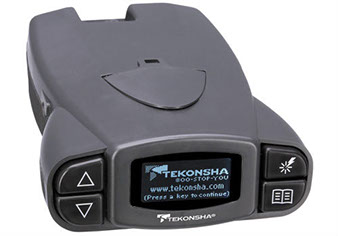Trailer Brake Controllers
If you are fitting electric drum brakes to your trailer, the brakes will require a controller which send an electrical voltage to turn the brakes on and off at the right time, as well as regulating how much braking is required.
There are two types of controllers available – Time Delayed & Proportional Control
Time Delayed Brake Controllers
Time delayed controllers are the most basic of the two controllers and are relatively cheap to purchase and easy to fit.
When the tow vehicle brakes are applied the controller gets a signal from the tow vehicles brake lights and then sends a predetermined amount of power (manually set prior to towing based on trailer weight) to the trailer brakes. There is then a timed delay to allow the braking effect to ramp up to full braking power (normally less than 1 second).
Most in cab time delayed controllers have a manual slide knob for applying the brakes in an emergency/panic situation.
Proportional Brake Controllers

Proportional controllers use an electronic pendulum or inertia device to detect the tow vehicles motion. While stationary or under normal forward motion, the pendulum will be in a vertical or rearward position. When the tow vehicle decelerates or slows down, the pendulum will swing forward, and depending on the amount of forward swing, the controller will apply a proportionate amount of voltage to the trailer brakes.
As the tow vehicle brakes, the controller will apply the same amount of braking pressure to the trailer brakes. If the tow vehicle brakes are fully applied, the trailer will have full braking power. This matching of the tow vehicle and the trailer has many advantages over time delayed braking and surge braking.
Proportional braking varies the amount of braking power according to the tow vehicles actual deceleration and results in smooth, precise and controlled braking of the trailer. Time delayed controllers will always send the same, set amount of power to the brakes, causing either the tow vehicle or trailer to brake harder and heavier. Premature wear and tear of the brakes is increased but with proportional control, the wear is spread evenly between the vehicles.
There are a couple of differing methods for the controller to sense the tow vehicles deceleration through braking. One popular system replaces the tow vehicles brake pedal rubber covering with a pressure sensitive pad. When the brake pedal is depressed, the pad senses the amount of foot pressure that is applied and the controller sends the appropriate amount of power to the brakes.
Another system has a sensor physically connected into the tow vehicles hydraulic brakes system. Again, as the tow vehicles brakes are applied, the sensor detects the brake fluid pressure and sends an electrical current via the controller to the brakes proportional to the tow vehicle.
As you can imagine these systems are quite expensive to purchase and fit and have the drawback of being fitted to one dedicated tow vehicle. These dedicated systems do have the edge over standard pendulum/inertia controllers. They exactly replicate the tow vehicles braking to the trailer and are not affected by differing road gradients and conditions as pendulum/inertia controllers can be.
Traveling over undulating, steep and winding roads, including gravel roads can affect the action of a standard inertia controller, causing it to apply brakes or to apply too much braking when minimal braking or no braking is required.
Most proportional controllers have inbuilt display screens showing the amount of voltage being applied to the brakes and the fancier models have fault and diagnostic information available.
All proportional controllers have an emergency/panic slider to allow the driver to manually apply the brakes if required. This is particularly useful if your trailer is prone to “trailer sway” and enables the brakes to be applied to the trailer only, and hopefully getting the trailer corrected quickly and safely.